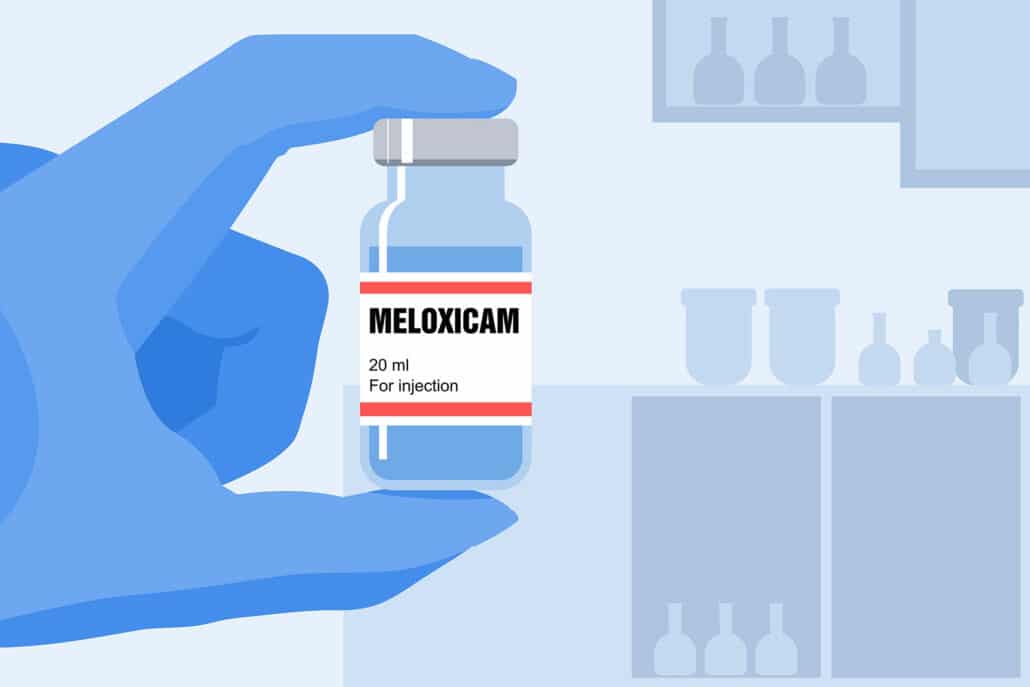Has your doctor prescribed you meloxicam for pain relief, inflammation, fever, or medical trauma? If so, you can take comfort: This drug is effective and relatively affordable. Especially important, it’s non-opioid and considered to be non-addictive.
Nevertheless, as is true of any medication, meloxicam abuse is possible. And, when misused, any prescription drug can become dangerous.
For that reason, you should always follow your meloxicam prescription exactly. Moreover, if you have any questions or concerns about this drug, you should contact your healthcare professional right away.
On top of that, it’s important to know how to wean off meloxicam safely.
Table of Contents
An Introduction to Meloxicam
Meloxicam is a drug that doctors prescribe for a range of disorders and health conditions. But it’s especially common as a treatment for chronic inflammatory conditions such as rheumatoid arthritis, juvenile rheumatoid arthritis, and osteoarthritis. And, in some cases, patients take this medication after a surgical operation.

The U.S. Food and Drug Administration approved meloxicam in 2000. And patients can consume it with or without food; it comes in tablet, capsule, and liquid suspension form. Mobic is a common brand name for meloxicam.
Meloxicam is classified as a non-steroidal anti-inflammatory drug, or NSAID. NSAIDs like meloxicam, ibuprofen, and naproxen work by inhibiting the body’s production of prostaglandins, chemicals that can cause or worsen inflammation, which in turn often causes pain.
Be aware that meloxicam occasionally causes side effects. They can include nausea, diarrhea, headaches, joint pain, and urinary tract infections. More serious side effects can include stomach ulcers, gastrointestinal bleeding, and kidney problems.
Why Weaning Off Meloxicam Is Important
Could you stop taking meloxicam suddenly and then experience no problems at all? The answer is yes; that’s very possible. However, that “cold turkey” approach comes with a few major risks:
1. Increased Chance of a Heart Attack
When patients suddenly stop taking NSAIDs, it can spike their inflammation levels. That abrupt rise in inflammation can allow blood clots to form, potentially leading to heart attacks.
This elevated heart attack risk generally lasts for a few weeks. And a patient who’d been taking an NSAID for a long time would be in greater danger of a blood clot.
Some people are more likely to have a cardiac episode to begin with — due to their diet, genetics, smoking habits, age, and so forth. They’d face a greater heart attack risk after abruptly discontinuing an NSAID than people in good cardiac health.
2. Increased Pain and Inflammation
If you stopped taking meloxicam all of a sudden, your pain and inflammation might come back right away. And that experience could be very hard to deal with — both physically and emotionally. Indeed, an onslaught of pain and swelling might interfere with your daily schedule, work responsibilities, family time, and social life.
What would happen, though, if you gradually lessened your meloxicam doses before you stopped taking the drug? Any new pain or inflammation would probably be much milder and thus much easier to manage.
3. A Psychological Dependence
Unlike some drugs — opioids, for example — meloxicam isn’t addictive. Thus, if you suddenly stopped taking this drug, you probably wouldn’t suffer any serious withdrawal symptoms. In fact, you might not notice any effects of meloxicam withdrawal at all.
Even so, people can develop a psychological dependence on this medication. That is, they might fear living without it. And, if they stopped taking it and then experienced pain or inflammation, they might start taking the drug again.
Worse yet, patients sometimes start taking more meloxicam than their doctor prescribed. Or they might take it even after their prescription runs out.
Meloxicam misuse comes with its own set of risks. It can cause health problems such as the following:
- High blood pressure
- Kidney failure
- Liver damage
- Depression
- Insomnia
- Anxiety

Steps to Safely Wean Off Meloxicam
With those risks in mind, the best way to end your use of meloxicam would be creating a tapering schedule. That is, your healthcare provider could provide you with a timeline for gradually and incrementally lessening your meloxicam dosages.
You’d then follow your tapering schedule to the letter. During this period, you’d carefully monitor your own health and well-being, too. In particular, you’d keep an eye out for any unusual symptoms.
Should you experience any physical or mental health issues, you’d see your healthcare provider right away. And, after examining you, this medical professional could make adjustments to your tapering schedule as necessary.
In short, that’s how to wean off meloxicam with minimal discomfort and anxiety.
Tapering Table Example
| Week | Daily Dosage | Instructions |
| 1 | 15 mg | Continue with the full prescribed dose. |
| 2 | 10 mg | Reduce dosage to 10 mg daily. Monitor for any withdrawal symptoms. |
| 3 | 5 mg | Reduce dosage to 5 mg daily. Observe how your body reacts. |
| 4 | 5 mg every other day | Take 5 mg every other day to ease off the medication gradually. |
| 5 | Discontinue | Stop taking Meloxicam entirely. Consult your doctor if any issues arise. |
Important Notes
- Consult Your Doctor: Always consult with your healthcare provider before starting a tapering schedule.
- Monitor Symptoms: Watch for withdrawal symptoms or the return of pain and inflammation.
- Adjust as Needed: If symptoms worsen, your doctor may recommend adjusting the schedule.
Meloxicam is a nonsteroidal anti-inflammatory drug (NSAID) commonly prescribed to manage pain and inflammation. Understanding its detection times in various biological samples is essential for both clinical and compliance purposes.
Meloxicam Detection Times
| Biological Sample | Detection Window | Notes |
|---|---|---|
| Blood | Up to 24 hours | Meloxicam reaches peak plasma levels approximately 2.5 to 7 hours after ingestion and is detectable for up to 24 hours post-administration. |
| Urine | Up to 3-5 days | The drug is primarily excreted through urine, making it detectable for up to 3 to 5 days after the last dose. |
| Saliva | Up to 24 hours | Detectable in saliva for about 24 hours post-ingestion; however, saliva testing for meloxicam is uncommon. |
| Hair | Up to 90 days | While theoretically detectable in hair for up to 90 days, hair testing for meloxicam is rare and not typically utilized in standard practice. |
Factors Influencing Detection Times
- Dosage and Frequency: Higher doses and prolonged use can extend detection windows.
- Metabolic Rate: Individuals with slower metabolism may retain the drug longer.
- Age and Health Status: Older age and compromised liver or kidney function can prolong the presence of meloxicam in the system.
Please note that detection windows can vary based on individual factors and testing methods. Always consult with a healthcare professional for personalized information.

Alternatives to Meloxicam for Pain Management
Of course, stopping meloxicam often means finding new pain management techniques. Fortunately, many such tools and methods exist. Here are several examples:
- Physical therapy, which can strengthen weak or stiff body parts
- Yoga and Pilates
- Meditation and hypnosis, which can alter the brain’s perceptions of pain
- Acupuncture
- Massage
- Over-the-counter medications
- Holistic treatments, which involve combinations of the treatments listed above
For more severe chronic pain, electrical stimulation might be an option. This technique uses electrical currents to block or hinder the nervous system’s pain signals.
Some chronic pain patients undergo surgery as well.
Furthermore, a healthy lifestyle can help people avoid pain and inflammation. Components of such a lifestyle include:
- Enjoying a diet rich in anti-inflammatory foods like vegetables, fruits, and lean proteins
- Avoiding processed foods, which can worsen inflammation
- Staying hydrated throughout the day
- Regularly stretching and exercising to keep your body flexible and limber — and thus less prone to pain and injury
- Getting plenty of sleep each night as well as going to bed and waking up at roughly the same time each day
- Minimizing stress and anxiety via relaxation and mindfulness techniques
How Long Island Interventions Can Help
Are you struggling to end your usage of meloxicam — or any other drug, for that matter? If so, know that you’re never alone. Professional assistance is always available.
One facility that has helped countless patients over the years is Long Island Interventions, which is located in West Hempstead, NY
Long Island Interventions offers compassionate care to people who have a wide variety of addiction treatment needs and substance use disorders. We offer outpatient programs and other treatment options for those struggling with meloxicam addiction.
When people are dealing with medication dependence, we provide them with a comprehensive treatment program, one that’s tailored to their specific needs and lifestyles. And we offer monitored detoxification, individual counseling, and group therapy sessions.

The Importance of Professional Support
Professional support can be vital for long-term wellness. That’s because caring and dedicated experts can address the root causes of a patient’s addiction or substance misuse.
Plus, treatment professionals can help patients identify and avoid their triggers. (Triggers are social, psychological, and environmental factors that could lead a person to a substance abuse relapse.) We also encourage patients to participate in support groups during and after treatment.
In the end, prescription drugs can be lifesaving, but they can also pose serious risks. And those risks include addiction and dependence. That’s why, if you’re taking meloxicam or any other painkiller, it’s crucial to work with your healthcare provider to wean yourself off it.
If you’re having any difficulty with that weaning process, you can contact Long Island Interventions at any time for support and guidance. We want to help you live a life that’s happy, fulfilling, and free of chemical dependence — the life that you deserve.
Published on: 2024-12-31
Updated on: 2025-05-02

